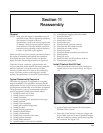
10.10
Section 10
Inspection and Reconditioning
Figure 10-10. Measuring Piston Ring Side
Clearance.
Install New Piston Rings
To install new piston rings, proceed as follows:
NOTE: Rings must be installed correctly. Ring
installation instructions are usually included
with new ring sets. Follow instructions
carefully. Use a piston ring expander to
install rings. See Figure 10-11. Install the
bottom (oil control) ring first and the top
compression ring last. Refer to Figure 10-12.
Replacement pistons are available in STD bore size,
and 0.25 mm (0.010 in.), and 0.50 mm (0.020 in.)
oversize. Replacement pistons include new piston ring
sets and new piston pins.
Replacement ring sets are also available separately for
STD, 0.25 mm (0.010 in.), and 0.50 mm (0.020 in.)
oversize pistons. Always use new piston rings when
installing pistons. Never use old rings.
Some important points to remember when servicing
piston rings:
1. The cylinder bore must be deglazed before
service ring sets are used.
2. If the cylinder bore does not need reboring and if
the old piston is within wear limits and free of
score or scuff marks, the old piston may be
reused.
3. Remove the old rings and clean up the grooves.
Never reuse old rings.
4. Before installing the new rings on the piston,
place the top two rings, each in turn, in its
running area in the cylinder bore and check the
end gap. See Figure 10-9. Compare the ring gap
to the specifications listed in Section 1.
Figure 10-9. Measuring Piston Ring End Gap.
5. After installing the new compression (top and
middle) rings on the piston, check the piston-to-
ring side clearance. Compare the clearance to
specifications listed in Section 1. If the side
clearance is greater than specified, a new piston
must be used. Refer to Figure 10-10.
Figure 10-11. Installing Piston Rings.
Piston Ring
Piston Ring
Expander


















